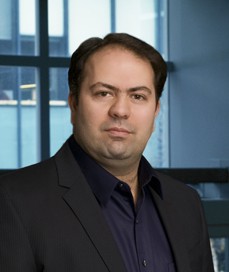Penn Engineering Professor Awarded NASA Grant to Improve Satellite Communication
By Jacob Williamson-Rea
When someone sends a YouTube video to a friend, microwaves carry that signal from their phone to a nearby transmission station on the ground. The station then fires the signal up to a near-Earth satellite, and then the satellite bounces the signal back down to Earth to a ground station near the recipient of the video.
The same goes for cellphone calls, TV broadcasts, and more. Satellites act as a network of information mirrors, allowing us to bounce information from one side of the planet to the other.

Firooz Aflatouni, Skirkanich Assistant Professor in Penn Engineering’s Department of Electrical and Systems Engineering, has been awarded a NASA Early Stage Innovations grant to design and implement arrays of optical antennas that can enable laser communication in near-Earth satellites, which will be more efficient and carry far more information than microwaves.
When a ground station fires microwaves to a near-Earth satellite, the microwaves lose a lot of energy and diverge before arriving at the intended satellite. Aiming at a relatively tiny, constantly moving target from thousands of miles away, only a small amount of the microwave signal reaches its intended destination. This limits the range and the amount of information microwaves can carry. As a result, soon microwaves may not be able to transmit data fast enough to keep up with rapidly evolving consumer demand.
Aflatouni aims to improve this system and will design precise laser emitters capable of sharing up to 10GB of data per second between satellites. His research will be conducted in Penn’s Electronic Photonic Microsystems Lab.
The amount of information that can be transmitted per signal is a question of frequency and energy. Microwaves waste a significant amount of energy because they diverge significantly as they travel with only a fraction of the original signal actually hitting its target.
Alternatively, lasers with much higher frequency will allow the satellites and stations to send signals in tight beams rather than wide cones.
“The energy in a laser beam is very focused, so the range is much farther than the range of microwaves, and the laser frequency is much higher than that of microwaves, so more information can be packed in a beam of light than microwaves” Aflatouni says. “This will enable satellites and stations to send more information farther and more quickly.”
To achieve his aims, Aflatouni will design microchips that contain antennas called “optical phased arrays.” Optical phased arrays can steer and direct a laser without using mechanically moving parts. This has multiple benefits: parts require a motor, which adds weight and cost to a satellite, and moving parts also require energy, which is difficult for satellites to produce while in orbit.
“Motors are power hungry,” says Aflatouni. “This new system will not only be faster, it will be light, small and inexpensive instead of heavy, slow and costly. Also, by using this technology, satellites can quickly track one another in a network of near-Earth satellites.”

Optical phased arrays will be placed on each of twelve sides of a dodecahedron module to provide 360-degree coverage around the satellite, enabling the ability to constantly communicate with any other satellite.
Given the range, the ability to share information at 10GB per second is unprecedented. In comparison, the modems in peoples’ homes share information at just 50MB per second.
One of the many benefits of this technology will be the ability to send videos in less than a fraction of a second thanks to the high data rate capabilities. This can potentially speed up everything from ultra HD streaming to cloud and distributed computing.
This NASA Early Stage Innovation grant of $500,000 aims “to accelerate the development of groundbreaking, high-risk/high-payoff space technologies to support the future space science and exploration needs of NASA, other government agencies, and the commercial space sector.”
